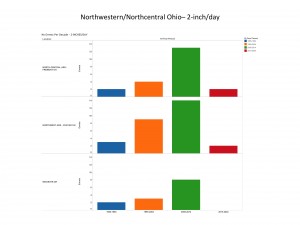The Annual Muck Crops School has been held in Willard, Ohio for the past 70 years. During this year’s school on January 8, my vegetable disease management update focused in part on diseases caused by oomycetes (Phytophthora blight, downy mildew), with a special emphasis on the use of Orondis (oxathiapiprolin; OXTP) on muck vegetables (see SMillerMuckCropsSchool7Jan2016compr). Use of this product for cucumber and melon downy mildew management is pretty straightforward – only the Orondis Opti co-pack, which contains OXTP and Bravo, is recommended. The number of applications are limited to a maximum of six in a season, AND a maximum of 1/3 of the total downy mildew fungicide applications. So for example, if six total fungicide applications are made for downy mildew during the season, no more than two can contain OXTP.
Use of Orondis for Phytophthora blight management in cucurbits and peppers is a little more complicated than for downy mildew. Drench and drip applications of Orondis Gold and Orondis Ultra are labeled, but if they are used as soil applications, foliar applications are not permitted. Muck crops growers have not used Ridomil much in the past, so Phytophthora populations may not be insensitive to Ridomil as they are in other areas, so Orondis Gold soil applications could be considered. However, there is not much information on the efficacy of soil applications of OXTP on soils with high organic matter or high clay content available, and our previous studies with OXTP indicated that foliar applications were more effective than soil applications. OXTP does not move much in soil, so it must be applied right to the root zone. So for muck soils or even transitional muck soils, I am not recommending soil applications of OXTP at this time. Growers using OXTP foliar applications should do so preventatively and use foliar applications of Orondis Ultra or Orondis Gold, with the same restrictions as described above for downy mildew.
I also presented data on bacterial disease management in vegetable crops. This is still a difficult topic because bacterial diseases are becoming more and more of a problem, particularly in northern Ohio where the weather pattern the past decade has been characterized by many more intensive rainfall events than in previous decades. The graphs below chart the number of rainfall events of >2 inches in a 24 hour period. These intensive rainfall events are very conducive to the development and spread of bacterial diseases.

Number of rainfall events > 2 inches in 24 hours in northern Ohio by decade. blue = 1985-1994; orange = 1995-2004; green = 2005-2014; red = 2015. Weather data are from OSU Agricultural Experiment Stations in Fremont (North Central; top row), Custar (Northwestern, middle row) and Wooster (bottom row). Ag. Experiment Station in Fremont (top row). Chart prepared by Chip Styer, OSU-OARDC.
I wish that I could report the availability of products highly effective against bacterial diseases, but there are none in the market at this time. At best some products, particularly those such as Actigard, K-Phite and Fracture that “activate” the plant’s own defense system, may reduce bacterial diseases to some extent. I have recommended sanitizing seed treatments for many years, with good success for seed borne bacterial diseases in tomatoes, peppers and pumpkins. Our 2015 results with hot water- or chlorine-treated parsley and collards seeds were pretty inconclusive, mainly due to low disease development. We will try again in 2016.
You can find more information in my Muck Crops School presentation: SMillerMuckCropsSchool 7Jan2016compr.
